 Museum
Museum  |
Bomber Command
|
Aircrew Chronicles
|
Aircrew Losses
|
Nose Art
|
BCATP
|
Lancaster
|
Media
|
Bomber Command
|
Aircrew Chronicles
|
Aircrew Losses
|
Nose Art
|
BCATP
|
Lancaster
|
Media
 Museum
Museum  |
Bomber Command
|
Aircrew Chronicles
|
Aircrew Losses
|
Nose Art
|
BCATP
|
Lancaster
|
Media
|
Bomber Command
|
Aircrew Chronicles
|
Aircrew Losses
|
Nose Art
|
BCATP
|
Lancaster
|
Media
Bomber Command Museum Archived Newsletters
The aircrew of Bomber Command and Fighter Command get credit for Canada's war efforts. But, as the picture below shows, it was the ground crew of the 442 Squadron, RCAF who solved the Y2K problem in August of 1944. With a new engine installed in the Spitfire, the problem with Y2K was over and she went on to fight another day. Where are these 442 ground crew members now that there seems to be another Y2K problem?" |
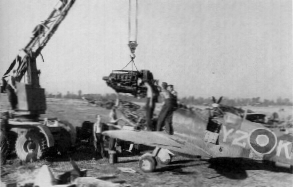 (former 635 Squadron Royal Air Force) |
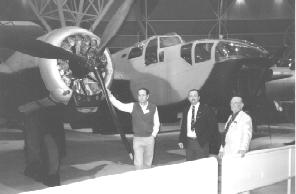 National Avaition Museum Blenheim (1997): Dave Birrell, Dan Fox, and Bob Evans in front. The NLS Blenheim will look something like this by August 12, 2000. |
 The Blenheim's starboard wing full of "clecoes." They hold the new aluminum skin in place for riveting. |
August 12, 2000
is the date of your Society's annual event as detailed above.
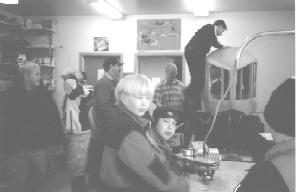 try out their flying skills on the Link Trainer. |
 |
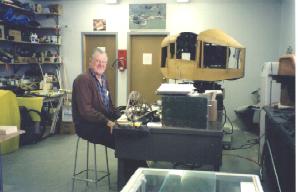 |
In the photo below are some of the 30 aircraft models that were donated to the museum by Murray Farquharson of Calgary. They include Lancasters, Short Stirling, several Spitfires, etc. Murray's friend and fellow modeler, Elmer Holm, arranged for the models to be given to our museum. A few planes from this scollection are being completed and/or repaired for later pickup. Several are already on display in the museum. Our THANKS to Murray and Elmer. |
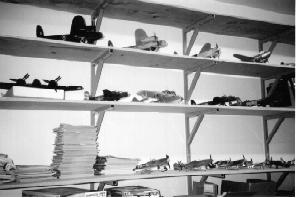
|
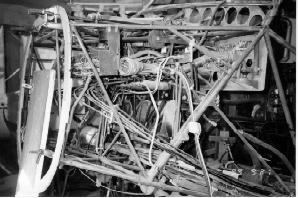 NOTE: The Crane is still in storage on a farm as of May 10. The Fall newsletter will have photos of the whole aircraft. |
 standing on edge - still in storage. The aircraft will be hauled sometime in May |
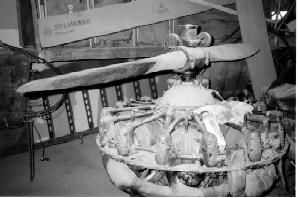 |
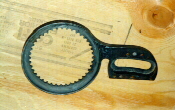
|
The photo below is of an original painting by Allan King, of Lethbridge, AB. It was painted in honour of this brother who was lost during WWII. Allan, himself a WWII veteran, donated this painting to the NLS museum through the Royal Canadian Legion #4 of Lethtbridge. It was accepted on behalf of the Society by NLS secretary, Jim and Pauline Wiersma, and president Dan Fox, at a Legion #4 meeting in February. The painting is unique. When viewed from different positions, the on-coming Lancaster in the painting appears to be always headed right at the viewer! Our grateful THANKS go out to Allan King and the Lethbridge Legion for adding this unique painting to our collection. |

|
|
Now on display in the museum is a small but very significant display dipicting the bravery of an Alberta woman who tried to rescue an airman from a crashed and burning aircraft during WWII. On November 10, 1941, a Tiger Moth aircraft from No. 2 Wireless School in Calgary crashed in the yard of Big Hills Springs School north of Cochrane, Alberta. Even though he had been injured in the crash and his clothes were on fire, the trainee aboard the aircraft, L.A.C. Karl Gravel, attempted to rescue the pilot from the burning wreckage. Frances Walsh, the teacher at the school, "displayed great personal courage and coolness" in rushingnto the fire, dragging L.A.C. Gravel from the flames, and rolling him on the ground to extinguish the flames which by this point had completely enveloped his clothing. Mrs. Walsh suffered burns to her arms, hands, and face but made no comment regarding her own injuries until medical officers had cared for the injured airman. Sadly, the aircraft's pilon, F/O James Robinson had been killed instantly in the crash and L.A.C. Gravel died later in hospital. He was awarded the George Cross for his attempt to save his pilot. Frances Walsh was awarded the George Medal, one of the highest civilian awards available at the time, for her unselfish acts. The presentation was made in Rideau Hall by the Governor General. It was the first time a Canadian woman had received the award. Mrs. Walsh's family has placed the medal on long-term loan with the Society. |
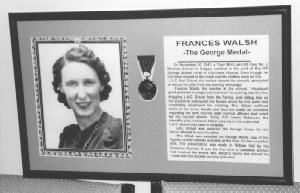 Frances Walsh - George Medal display. |
In the foreground, Bob Long, local rep for Mobil Oil, works on one of the Blenheim wings along with AME Greg Morrison (centre) and NLS director, Bob Braid, it the background, on a Tuesday work night. |
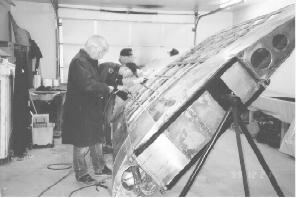
|
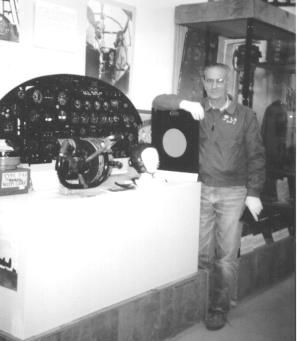
|
Volunteer, John Philips, from High River has cleaned and upgraded all the Lanc crew displays. John is a regular on Tuesday work nights and has done everything from paint to repair radios. |
Mrs. Elsie Manford sent us the above photo of her husband, former W.O. WAG, Malcolm Manford, manning the restored rear turret when the couple visited the museum about four years ago. |

|
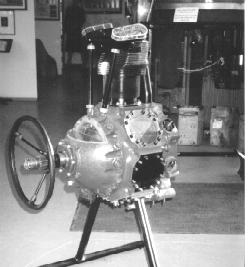
|
"Hands on" exhibit of a cutaway Jacobs engine donated by museum members, Peter Maclin, High River, and Alvin Berger, Nanton. The visitor can turn the engine over by hand and view the cylinder and valve train going through their cycles as the crank shaft is turned. THANKS to Peter and Alvin for their generosity. |
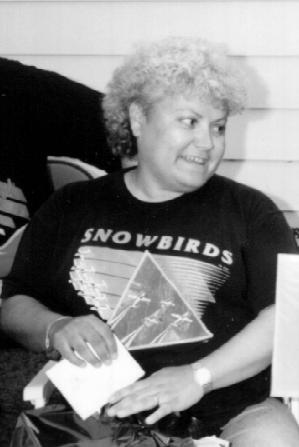
* Bill Prince *
Stoke on Trent, England
Our Society was saddened to hear that Bill Prince, of Stoke on Trent, England, passed away suddenly in February.
Many of our members will remember Bill and his wife Margaret were our very special guests at last year's major function which honoured Bill's father, Sgt. Albert Stanley Prince, the first Canadian airman killed during WWII. Bill, along with Jim Foster, a cousin of Albert's, had helped to unveil the permanent display honouring his father and all other servicemen who gave their lives during WWII.
The Society extends condolences to the Prince family in their loss.
* Delbert "Del" Todd *
Calgary, Alberta (formerly of Nanton), served with the RCAF during WWII as an airframe mechanic.
* Lois Yeoman *
Edmonton, Alberta, friend of the Society, passed away in late 1999. Lois was a sister of W.O. (WAG) Aldon Cottam, killed on the Dams Raid.
* Don Vance *
Marysville, B.C. Long time member - donator of the "400" squadron plaques and many other artifacts.
* Jim Dow *
DSO DFC & Bar - Winnipeg, Manitoba - passed away February 22, 2000. Jim attended our 1996 Dedication Event. He was an observer who frew over 100 ops; 70 with the PFF including 45 with 635 Sqd. He became a Squadron Leader and is thought to be the most highly decorated navigator in the RCAF. He was Ian Bazalgette's room-mate for a while as well.
* Stan Dowhan *
Canmore, Alberta, NLS member passed away in January, 2000.